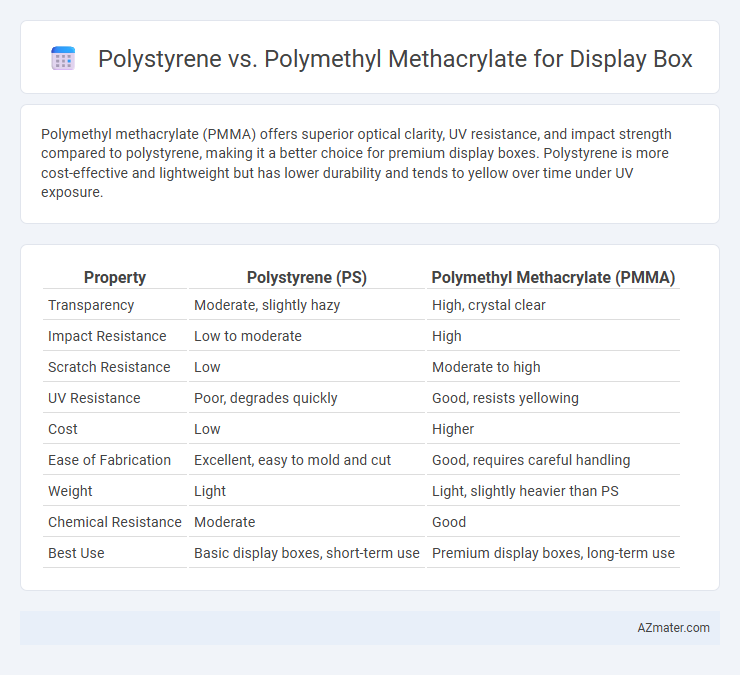Polymethyl methacrylate (PMMA) offers superior optical clarity, UV resistance, and impact strength compared to polystyrene, making it a better choice for premium display boxes. Polystyrene is more cost-effective and lightweight but has lower durability and tends to yellow over time under UV exposure.
Table of Comparison
| Property | Polystyrene (PS) | Polymethyl Methacrylate (PMMA) |
|---|---|---|
| Transparency | Moderate, slightly hazy | High, crystal clear |
| Impact Resistance | Low to moderate | High |
| Scratch Resistance | Low | Moderate to high |
| UV Resistance | Poor, degrades quickly | Good, resists yellowing |
| Cost | Low | Higher |
| Ease of Fabrication | Excellent, easy to mold and cut | Good, requires careful handling |
| Weight | Light | Light, slightly heavier than PS |
| Chemical Resistance | Moderate | Good |
| Best Use | Basic display boxes, short-term use | Premium display boxes, long-term use |
Introduction to Display Box Materials
Polystyrene and polymethyl methacrylate (PMMA) are two of the most common materials used for display boxes, each offering unique advantages in clarity, durability, and cost-effectiveness. Polystyrene provides excellent rigidity and impact resistance, making it suitable for protecting delicate items while maintaining transparency. PMMA, also known as acrylic, delivers superior optical clarity and weather resistance, ideal for high-end displays requiring long-lasting visual appeal and UV stability.
Overview of Polystyrene (PS)
Polystyrene (PS) is a versatile thermoplastic polymer widely used in display boxes due to its clarity, rigidity, and cost-effectiveness. It offers excellent impact resistance and is easy to mold, making it ideal for protective packaging and product showcases. PS is lightweight and can be produced in both transparent and opaque forms, providing flexibility in design and presentation.
Overview of Polymethyl Methacrylate (PMMA/Acrylic)
Polymethyl Methacrylate (PMMA), commonly known as acrylic, offers superior clarity and UV resistance compared to polystyrene, making it an ideal choice for high-quality display boxes. Its excellent shatter resistance and lightweight properties enhance durability and ease of handling while maintaining optical transparency up to 92%. PMMA also provides greater weatherability and scratch resistance, ensuring long-lasting visual appeal in retail and exhibition environments.
Clarity and Visual Appeal Comparison
Polymethyl methacrylate (PMMA) offers superior optical clarity compared to polystyrene, with light transmittance rates up to 92%, making it ideal for display boxes that require high transparency and vibrant visual appeal. Polystyrene, while more cost-effective, typically has lower clarity and can yellow over time, reducing the aesthetic quality of the display. PMMA also resists UV degradation and provides better surface hardness, preserving the pristine look of showcased products.
Durability and Impact Resistance
Polymethyl Methacrylate (PMMA) offers superior impact resistance compared to Polystyrene (PS), making it less prone to cracking or shattering in display box applications. While Polystyrene provides good rigidity and cost-effectiveness, its lower durability under stress limits its long-term use for protective and high-traffic displays. PMMA's enhanced toughness and weather resistance ensure greater longevity and robustness in demanding retail environments, resulting in a more durable display box solution.
Weight and Handling Differences
Polystyrene (PS) is significantly lighter than Polymethyl Methacrylate (PMMA), making it easier to handle and transport for display box applications. PS offers greater flexibility and impact resistance, reducing the risk of cracking during installation or movement, whereas PMMA, being heavier and more rigid, provides superior clarity but demands more careful handling. The weight difference directly impacts shipping costs and ease of assembly, with PS favored for lightweight, budget-conscious solutions while PMMA suits premium displays requiring high transparency and durability.
Cost Analysis: Polystyrene vs PMMA
Polystyrene offers a cost-effective solution for display boxes with material prices significantly lower than polymethyl methacrylate (PMMA), making it ideal for budget-sensitive projects. PMMA, although more expensive, provides superior optical clarity and durability, justifying its higher cost in premium display applications. Manufacturing expenses also vary, as polystyrene processes are simpler and faster, reducing overall production costs compared to the more complex molding and finishing required for PMMA.
UV Resistance and Long-Term Performance
Polymethyl Methacrylate (PMMA) outperforms Polystyrene (PS) in UV resistance, maintaining clarity and structural integrity under prolonged sunlight exposure. PS tends to yellow and degrade over time when exposed to UV rays, reducing its suitability for long-term display applications. PMMA's superior weatherability and durability make it the preferred material for display boxes requiring sustained aesthetic appeal and performance.
Application Suitability: Which Display Box for Your Needs?
Polystyrene offers excellent clarity and rigidity, making it ideal for lightweight display boxes that require sharp detail and cost-effectiveness. Polymethyl methacrylate (PMMA), known for superior impact resistance and UV stability, suits display boxes needing durability and long-term outdoor exposure. Choosing between polystyrene and PMMA depends on specific application needs such as budget, environmental conditions, and desired lifespan.
Environmental Impact and Recyclability
Polystyrene (PS) and Polymethyl Methacrylate (PMMA) differ significantly in environmental impact and recyclability; PS is derived from non-renewable petroleum sources and is less biodegradable, often contributing to persistent plastic waste, though it can be mechanically recycled where facilities exist. PMMA, while also petroleum-based, offers better environmental performance due to higher clarity and durability, promoting longer product life and potential for chemical recycling into monomers, reducing landfill accumulation. Choosing PMMA for display boxes enhances sustainability by supporting improved recycling processes and minimizing ecological footprint compared to conventional PS materials.

Infographic: Polystyrene vs Polymethyl Methacrylate for Display Box
 azmater.com
azmater.com